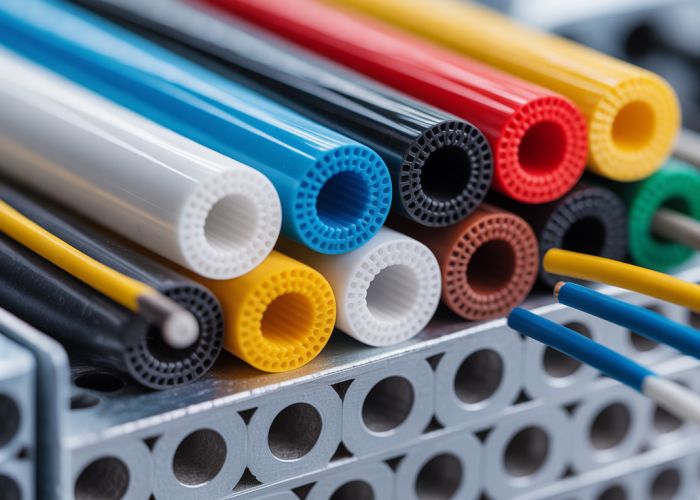The widespread use of Polymers in electrical applications raises the fundamental question: is plastic insulator a universally valid statement? Understanding the dielectric properties of materials is essential, and organizations like the IEEE provide standards for insulation testing. Common misconceptions about PVC, a specific type of plastic, often cloud the reality of its insulating capabilities. Moreover, the location where the insulator is used, be it a high-humidity environment or a dry climate, can affect its performance. This article delves into the multifaceted nature of plastic insulation, clarifying the facts and debunking common myths.

Deconstructing the Plastic Insulator: Unveiling Myths & Facts
This article aims to clarify the role of plastic as an insulator, addressing common misconceptions and presenting factual information regarding its electrical properties and applications. The focus will be on answering the core question: "is plastic insulator?".
Understanding Electrical Conductivity and Insulation
Defining Conductivity and Insulation
To understand how plastic behaves as an insulator, it’s important to first define these key concepts:
- Electrical Conductivity: A material’s ability to allow electric current to flow through it easily. Conductors, like metals (copper, aluminum), have many free electrons that can carry charge.
- Electrical Insulation: A material’s ability to resist the flow of electric current. Insulators, like glass, rubber, and certain plastics, have very few free electrons.
How Insulation Works
Insulators prevent electrical current from flowing freely because their electrons are tightly bound to their atoms. A strong electric field is required to dislodge these electrons and allow current to flow.
Is Plastic an Insulator? Assessing Its Electrical Properties
The General Rule: Plastics as Insulators
Generally, plastics are considered good electrical insulators. This is because their molecular structure doesn’t readily allow the movement of electrons.
Factors Affecting Plastic’s Insulating Properties
Several factors can influence how well a plastic insulates:
- Type of Plastic: Not all plastics are created equal. Some plastics have higher dielectric strength (ability to withstand voltage without breaking down) than others. Examples include:
- Polyethylene (PE): Commonly used in wire and cable insulation.
- Polyvinyl Chloride (PVC): Widely used in electrical wiring due to its flexibility and insulating properties.
- Polytetrafluoroethylene (PTFE) (Teflon): Excellent insulator with high temperature resistance.
- Polycarbonate (PC): Good impact resistance and insulating properties, often used in electronic components.
- Additives: Additives, such as fillers or flame retardants, can alter a plastic’s insulating properties. Some additives might reduce its insulating capability.
- Temperature: High temperatures can degrade a plastic’s insulating performance.
- Humidity: Moisture can reduce the effectiveness of certain plastics as insulators.
Comparing Plastics to Other Insulators
Here’s a comparison of plastics to other common insulators based on their insulating strength (dielectric strength):
| Material | Dielectric Strength (kV/mm) |
|---|---|
| Air | 3 |
| Paper | 14 |
| Glass | 10-40 |
| Rubber | 20-40 |
| PVC | 20-45 |
| Polyethylene | 20-50 |
| PTFE (Teflon) | 60-173 |
Note: These values are approximate and can vary depending on the specific composition and testing conditions.
Applications of Plastic Insulators
Common Uses in Electrical Systems
Plastics are extensively used as insulators in various electrical applications:
- Wire and Cable Insulation: Protecting wires and cables from short circuits and preventing electric shock.
- Electrical Housings and Enclosures: Encasing electrical components to prevent contact with live parts.
- Circuit Boards: Providing a non-conductive base for electronic components.
- Switches and Outlets: Insulating live contacts to ensure safety.
- High-Voltage Applications: Specialized plastics are used in high-voltage equipment to prevent arcing and breakdown.
Examples of Specific Plastic Insulator Applications
- PVC is frequently used to insulate household wiring due to its cost-effectiveness and flexibility.
- Polyethylene is found in coaxial cables and other low-voltage applications.
- PTFE (Teflon) is used in high-temperature applications where other plastics would degrade.
Addressing Common Myths About Plastic Insulators
Myth 1: All Plastics are Perfect Insulators
This is incorrect. As mentioned previously, the type of plastic, additives, temperature, and humidity all affect a plastic’s insulating capabilities. Some plastics are better insulators than others.
Myth 2: Plastic Insulators Don’t Degrade
Plastics can degrade over time due to exposure to UV radiation, heat, and chemicals. This degradation can reduce their insulating performance and lead to failure.
Myth 3: Plastic Insulators are Environmentally Friendly
While plastics are useful, their disposal poses environmental challenges. The production and disposal of certain plastics can contribute to pollution. However, advancements are being made in recyclable and biodegradable plastics to mitigate these issues.
FAQs: Plastic Insulator Myths & Facts
Here are some common questions about plastic insulators, debunking myths and clarifying the facts.
Is all plastic equally effective as an insulator?
No, not all plastic is created equal. Different types of plastic have varying levels of electrical resistance. Therefore, some plastics are far better insulators than others. The specific composition and structure determine how effective a specific plastic is plastic insulator.
Can a plastic insulator completely prevent electrical current flow?
While a plastic insulator significantly restricts current flow, it’s not a perfect barrier. Under extremely high voltage, even the best plastic insulator can experience dielectric breakdown, allowing some current to pass through.
Are plastic insulators environmentally friendly?
The environmental impact of plastic insulators is a complex issue. While durable and long-lasting, many plastics are not biodegradable and contribute to plastic waste. However, some newer plastic insulators are being developed with recycled or biodegradable materials.
How does temperature affect the performance of a plastic insulator?
Temperature can affect the insulating properties of plastic. High temperatures can soften or melt some plastics, reducing their electrical resistance. Lower temperatures can make some plastics brittle and prone to cracking, thus impacting its performance as a plastic insulator.
So, hopefully, you now have a clearer picture of whether is plastic insulator or not! Keep exploring, keep questioning, and don’t be afraid to dive deeper into the world of materials science.